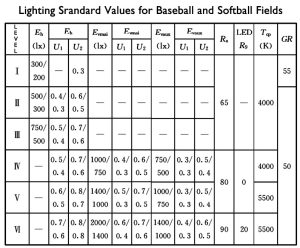Baseball Field Lighting
Effective lighting design is critical for baseball and softball fields to ensure optimal visibility for players, officials, and spectators while meeting safety, performance, and broadcast standards. Below is an overview of key considerations and strategies for designing lighting systems for these sports venues.
https://youtube.com/@weiyadi?si=FlaTpzSLWZOqKr2_
here is the baseball field Lighting Standard

1.Design Standards and Requirements of Baseball Field Light
Lighting systems must comply with international and regional standards, such as those set by the International Commission on Illumination (CIE), World Baseball Softball Confederation (WBSC), or ANSI/IESNA RP6 for sports lighting. Key parameters include:
Illuminance Levels: Vary based on the field’s purpose (e.g., recreational, collegiate, or professional).
Baseball (Professional): 500–1,000 lux (horizontal) for infield/outfield; 750–1,500 lux for televised events.
Softball: Slightly lower requirements due to smaller field dimensions (300–750 lux).
Uniformity: Horizontal and vertical uniformity ratios (U1 and U2) should exceed 0.6 to eliminate dark spots.
Glare Control: Minimize glare for players and spectators using shielded fixtures and precise beam angles.
Color Rendering: Use high CRI (>80) LED luminaires to enhance visibility and broadcast quality.